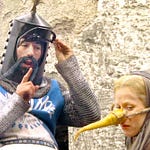Show me a man who believes in conspiracy theories and I’ll show you someone who has never organised a surprise party.
—Lee Harvey Oswald.1
The constant presence
Ordinarily, when a defendant appears on 22 counts of things like murder, there is a wealth of compelling evidence: eyewitnesses, fingerprints, incriminating forensics and related corroborations that point not just to murder, but to the defendant, specifically, committing each one.
Ms. Letby’s case seemed quite different. The evidence largely focused on whether, in each case, there had been a crime at all. Expert evidence challenged the presumption that the collapses were just part of the ordinary run of medical emergencies one would expect in a busy intensive care unit.
There was a curious missing step: the prosecution seemed founded on the tacit assumption that, as long as they could prove these to be malicious acts, it went without saying that they were carried out by Ms. Letby. This, it implied, could be inferred by her “constant presence”.
Was that tacit assumption justified?
Prelude: tragedies in the air
On October 29, 2018, a Boeing 737-MAX operated by Lion Air, a carrier operating in Southeast Asia, crashed into the Java Sea, killing all on board. Five months later Ethiopian Airlines, a carrier operating in Africa, lost a Boeing 737-MAX when it crashed into farmland near Bishoftu.
At around the same time, there were a series of other air accidents: an Air Niugini Boeing 737 crashed into a lagoon in Micronesia. A Fly Jamaica Boeing 757 overran a runway in Guyana. A Saha Airlines Boeing 707 crashed in Iran.
Though all involved Boeing airliners the crashes seemed, as air crashes generally do, unrelated: they involved different airlines, on different continents, at different altitudes, over different terrain, at different times of the year and in different weather conditions.
Air crash investigators were called in and began to review the black box flight data records.
They soon began to notice unusual similarities between the two 737-MAX crashes.
MCAS: a villain in the room
Sometimes, when you look closely, the circumstances surrounding apparently unrelated events are so similar as to invite the inference that they have a common cause. Airline crashes are vanishingly rare and, except where planes crash into each other, are almost always unrelated.
They tend to arise from a complex mix of causes: pilot error, terrorism, atmospheric conditions, garbled air traffic control instructions, freight loading, autopilot mis-programming, mechanical malfunctions and even ground-to-air missile attacks. Each tends to be sui generis because the global aviation system learns from its mistakes. It is very good at isolating, minimising and not repeating catastrophic risks.2
The two 737-MAX crashes stood out. They were uncannily similar. Both airliners were more or less brand new. Both crews experienced erratic altitude changes shortly after takeoff. In both cases, the computerised navigation system repeatedly, inexplicably, forced the plane’s nose down while the crew struggled to force it back to level. In both cases, the autopilot eventually overrode the crew’s manual intervention, whereupon the planes plunged irrecoverably towards the earth.
Air crash investigators soon identified a common culprit: Boeing’s state-of-the-art “Manoeuvring Characteristics Augmentation System” (MCAS) was installed on both airliners.
“MCAS” was designed to automatically push the plane’s nose down in certain conditions, to prevent stalling. But it relied on readings from a single “angle-of-attack” sensor, with no redundancy if it failed. When the sensor provided incorrect data, as it did in both cases, MCAS repeatedly forced the nose down. Boeing had not alerted airlines about the new system, and pilots were not trained how to manage it. The system could, in any case, override pilot inputs and there was no easy way to disable it in an emergency.
For those two 737-MAX crashes, there was a single villain in the room: MCAS.
A villain in the room at Countess of Chester?
With that analogy in mind, we come to the Countess of Chester Hospital in 2016. It had suffered, in effect, a series of baffling air crashes over a short period. But what had caused them? Was they just part of a random cluster, or was there a proverbial villain in the room?
Like airline accidents, individual hospital collapses tend to be independent. Each patient arrives with her own pathology, and her outcome depends on how effective the hospital treatment is on her pathology. Generally, when patients die, it is because the hospital could not save them, rather than because something else at the hospital killed them.
This is not necessarily the case, of course. But if something, or someone, at the hospital is creating collapses, we should expect an improbable convergence of knock-on effects: symptoms, conditions and outcomes that indicate there is a common cause, just as we would with related air crashes.
We should expect corroborating evidence.
A word about the standard of proof
Aquick reminder that the Crown must make the running in a criminal trial. Proving guilt is thoroughly, at times tediously, analytical. Each crime is made up of a set of legal components. The Crown must satisfy the jury of each one. It does that by presenting evidence — facts — to support each legal component. This exercise is no sense “impressionistic”. It is painstaking, and exacting. It is why criminal proceeedings take as long as they do. You have to prove even obvious things, that no-one seriously doubts.3
There is a major distinction between “law” — the legal components comprising a crime — and “fact” — the evidence presented to “prove” those components. Law is for the judge; facts are for the jury. A big part of the judge’s job is to guide the jury as to the legal components. The judge will slowly and carefully walk the jury through the logic of components they must navigate to reach their verdicts. Once that is done, what they do behind closed doors, on the other hand, is a mystery.4
In any case, the standard of proof for each component is very high: in the vernacular, the jury must be satisfied “beyond reasonable doubt”. The Crown must bring compelling evidence to support every component of every offence.
Strikingly similar evidence and the serial murderer’s modus operandi
This can put a prosecution in a dark place. Especially if it is dealing with a sophisticated criminal. Serial murderers generally only get away with it long enough to become “serial murderers” by not leaving incriminating evidence lying around. They avoid being seen by those who live to tell the tale. They are meticulous in cleaning up after themselves. That makes them hard to find, and even harder to convict.
But, that is how it is: just because the perpetrator is a wizard that does not mean the Crown is excused from meeting its evidential burden. “Beyond reasonable doubt” means what it says: to convict a defendant of multiple murders, you must prove every aspect of every one.
Now, a serial murderer may have a unique modus operandi. She may keep trophies.5 She may leave a kind of grisly calling card — a bullet-holed queen of hearts on the forehead, say — unusual enough to permit the inference that, if the “Lonely Hearts Killer” did that one, then he must have done these ones, too.
The law has developed strategies to accommodate these “signatures”. One is the “strikingly similar” evidence rule: the Crown may present incontrovertible evidence that a defendant committed one offence to prove that she must have committed another if the offences, or how they were committed, are so “strikingly similar” that they function as a “behavioural fingerprint”.
The courts will not infer such a thing lightly, however: a “signature” needs to be strong enough to support the inference, that the defendant’s involvement is the only plausible explanation.
It must be highly unlikely to occur by chance or to be independently replicated by a different perpetrator. If so, this is a convenient heuristic for police: it saves them having to find eyewitnesses for all the bodies stacked up in the county morgue that are decorated with bullet-holed playing cards. The defence may defeat the argument by presenting evidence and argument rebutting those inferences.
Here there was very little direct evidence implicating Ms. Letby for the charged offences. If the Crown wanted to claim she had nevertheless left behind a “behavioural footprint”, it had two problems.
Non-similarity
There was premeditation, calculation and cunning in your actions. [...] You used a number of different ways to try to kill them, thereby misleading clinicians into believing the collapses had, or might have had, a natural cause or were a consequence of a developing medical condition.
—Mr. Justice Goss’s sentencing remarks, 21 August 2023.
Firstly, the collapses weren’t strikingly similar. To the contrary, if things were as Mr. Justice Goss saw them, Ms. Letby was artful in how she switched up her methods to make the offences look different. The Court cited this very calculatedness as a measure of her cruelty.
According to the Crown, Ms. Letby attempted murder, variously, by injecting air into infants’ bloodstreams, pumping air into their stomachs, administering factitious insulin, overfeeding, tampering with breathing tubes, disabling oxygen saturation alarms and, in one case, physical violence.
But it produced no evidence of Ms. Letby, herself, actually doing any of these things.
This seems to be a long way from “striking similarity”. There is no “signature” to these events, let alone anything intrinsic that distinguishes them from accidental medical emergencies.
The Crown might assert that Ms. Letby was simply so cunning that she avoided leaving evidence. But it must produce evidence of that acuity. It does not seem to have done so.
The Crown needed, therefore, to produce cogent evidence tying Ms. Letby, specifically, to every allegation: if not direct eyewitness evidence, then cogent circumstantial evidence that it can only have been her.
It didn’t have a lot of this, either.
Non-identification
Secondly, the only “striking” thing about the identification evidence was how weak it was. There was evidence that the collapses were “consistent with” someone’s deliberate harm — the allegedly factitious insulin, for example — but little of it pointed to an individual, let alone Ms. Letby.6
This becomes clearer when taking the evidence for each charge in isolation. Take the following hypothetical:
If this charge were laid by itself, would there be enough evidence to find Ms. Letby guilty of murder beyond reasonable doubt?
The best case to do this is Child K, because it was (re)tried alone, albeit against a background of Ms. Letby’s existing convictions. It also featured what the Crown considered the strongest evidence directly incriminating Ms. Letby: the “virtually red-handed” episode.7
“We say Lucy Letby had been caught virtually red-handed by Dr. Jayaram.”
—Nick Johnson, KC, opening in the retrial of Child K, 12 June 2024.
Mr. Johnson KC opened the Crown’s case in the retrial as follows:
“So, when Dr. Jayaram walked into the nursery, he saw Lucy Letby was standing over [Child K] and her blood oxygen levels were falling, but the alarm was not sounding. Not only that, but Lucy Letby was doing nothing.
We say that, in those circumstances, the only reasonable thing for a nurse to do would be to call for help and/or use the Neo puff to breathe for the child.”
The Crown alleged Ms. Letby tried to suffocate Child K by dislodging his breathing tube and switching off his desaturation alarm. According to this narrative, the infant was only saved by Dr. Jayaram’s timely intervention.
But no one saw Ms. Letby dislodging the breathing tube or disabling the alarm. Premature infants are tiny, move around a lot, and often dislodge their own breathing tubes. Another witness recalled hearing the alarm sound. Nor was there evidence it had been disabled or interfered with.
The “clincher” was Dr. Jayaram’s evidence. He told the court he entered the room to see Ms. Letby standing over Child K’s incubator “doing nothing” while the infant collapsed.
But by itself, this is hardly strong evidence. It is a single account. It hardly rebuts all possible alternatives. We need not be detained by details, beyond emphasising that, on the evidence, Ms Letby’s behaviour was also “consistent with” not having tried to murder the infant. There was still plenty of reasonable doubt.
Whence a “signature”, then?
Well, Mr. Johnson KC alluded to one when he framed his case to the jury. It is subtle, though, so keep your eyes peeled:
“The reason [Child K] was desaturating was because that the breathing tube had been displaced and we suggest that the fact Lucy Letby was doing nothing and the fact the alarms were not sounding is evidence from which you can conclude that it was Lucy Letby, the convicted murderer, who had displaced the tube.”
There is only one reason for that parenthetical: Ms. Letby has already been convicted: that is the “signature”.
That is the Crown’s best chance of buttressing the meagre identification evidence for the immediate case.
But what are the odds—
There may be one last way the Crown might string something together. It doesn’t sound promising — pro-guilt commentators are easily riled by the suggestion that this might have anything to do with it — but there might be a case that statistics could provide the missing “signature”.
If the probabilities bear out the Crown’s theory, it may still have a compelling prima facie case that Ms. Letby was the murderer.
She says she was there by coincidence. We can measure that claim against the probability of it being true. If, as Ms. Letby says, the collapses had nothing to do with her — this is what statisticians call the “null hypothesis” — as far as she is concerned, they are random events.
The question to ask is this:
What are the odds that a full-time nurse would be on duty for 22 randomly chosen events by coincidence?
We can make a rough estimate.
We know Ms. Letby worked hard. Even with overtime, after weekends and holidays, she would have worked no more than one-third of all shifts. Let us give her the benefit of doubt and say she consistently worked a third of all shifts. Her chance of being on duty for any one shift was, therefore, ⅓. Thirty-three per cent.
A little bit of maths, then: to find the probability of several events all happening, you multiply their individual probabilities. If there was a 33% chance of Ms. Letby being on duty for one shift, then the chance of her being on duty for all of twenty-two randomly-chosen shifts is 33% multiplied by 33% twenty-one times. Thirty-three per cent raised to the power of 21.
This is a very small number. It is about one in 10.5 billion. There was a one-in-ten billion chance that Ms. Letby was rostered on for all suspect shifts by coincidence.
For the less mathematically inclined, that is, effectively, zero chance.
If the suspect shifts really were selected independently, we have our signature.
But it’s a big “if”.
To run it down, there are two further cross-checks to make.
Selection method
First, how were the offences selected? Were they, from Ms. Letby’s perspective, really random?
The damning probability calculation above only works if it is true there was a ⅔ chance Ms. Letby was not there for any particular shift.
But this presumes the police reviewed every single shift looking for suspect collapses “blind”: without any regard to who was on shift. If their methodology was different — if Ms. Letby was the prime suspect from the get-go, and they only considered her shifts when looking for collapses, then her probability of being on duty would not be 33%, but 100%. A certainty.
In this case, the chance of Ms. Letby being coincidentally on duty for all suspect shifts was 100%. Of course it would. The attendance chart with all those crosses in it tells us nothing.
So, how were the events selected? This is a fascinating question. I discuss it in “How did the police select the charges?”
How to explain missing corroboration
Secondly, if police did select the suspect offences blind, without reference to Ms. Letby’s presence and, probabilistically, Ms. Letby was therefore connected to the collapses, then if it were murder, we would expect consequential facts to be present. No action exists in a vacuum. No action is devoid of antecedents and consequences, least of all highly unusual ones like premeditated murder. Where are those consequential facts?
Where, indeed, are antecedent facts consistent with such outlying behaviour? It is hard to predict the future state of a complex system: I have bloviated at length about this elsewhere. It is much easier to trace its history. Where are the background circumstances that would lead a person to do such a thing?
This too is fascinating. I cover it in “Must the crown prove a motive?”
See also
No, he did not really say this.
Or did he?
Airline deaths per million passenger miles has constantly dropped since records began in the 1960s: see this chart from our world in data.
This is why I can confirm to you that the urban myth that “every bank note in circulation has traces of cocaine on it” is, in fact, not an urban myth. It is perfectly true. Some years ago now I sat in a courtroom, as a member of a jury, and listened to a forensics expert tell me that on oath. Cocaine is sticky stuff. It gets everywhere.
I know this also from personal experience. Jury deliberations are secret, and extremely impressionistic. For that reason, is one of the great sacred mysteries of law, and appeal courts will be most reluctant to enquire into it. Jurors are sworn, on pain of contempt of court, from revealing what went on during deliberations. I hope it will not jeopardise my own criminal record to remark that in my experience, “jury logic” did not ever reach the same crystalline heights of ratiocination that is demonstrated in open court.
Are we going to talk about the “handover notes as trophies” business? All right, if we must.
For detail on this, see the insulin smoking gun.
Reconstructed from quotes by the BBC and The Standard. Punctuation corrected and emphasis added.











Share this post